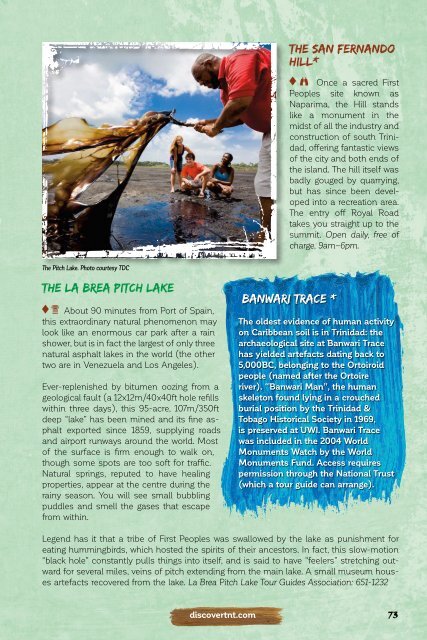Discover Trinidad & Tobago 2016 — 25th Anniversary Edition
With our 2016 edition (our 27th), we celebrate 25 years of producing Discover Trinidad & Tobago. Published every year since 1991, Discover Trinidad & Tobago is aimed both at international visitors planning a trip to the islands – whether for an eco adventure, business trip, or beach holiday – and at local Trinbagonians looking to know and explore more about their native islands. Our comprehensive coverage of Trinidad and Tobago — from arts and culture to eco adventures, accommodation to sports, planning flights and transportation and more — can help anyone plan anything from a day trip or weekend escape, to a full-on an adventure holiday or leisurely vacation. It might take a lifetime to truly experience all that the islands have to offer, but at least we can show you where to start. For more: http://www.discovertnt.com • http://www.facebook.com/discovertnt
With our 2016 edition (our 27th), we celebrate 25 years of producing Discover Trinidad & Tobago. Published every year since 1991, Discover Trinidad & Tobago is aimed both at international visitors planning a trip to the islands – whether for an eco adventure, business trip, or beach holiday – and at local Trinbagonians looking to know and explore more about their native islands. Our comprehensive coverage of Trinidad and Tobago — from arts and culture to eco adventures, accommodation to sports, planning flights and transportation and more — can help anyone plan anything from a day trip or weekend escape, to a full-on an adventure holiday or leisurely vacation. It might take a lifetime to truly experience all that the islands have to offer, but at least we can show you where to start. For more: http://www.discovertnt.com • http://www.facebook.com/discovertnt
You also want an ePaper? Increase the reach of your titles
YUMPU automatically turns print PDFs into web optimized ePapers that Google loves.
The San Fernando<br />
Hill<br />
Once a sacred First<br />
Peoples site known as<br />
Naparima, the Hill stands<br />
like a monument in the<br />
midst of all the industry and<br />
construction of south <strong>Trinidad</strong>,<br />
offering fantastic views<br />
of the city and both ends of<br />
the island. The hill itself was<br />
badly gouged by quarrying,<br />
but has since been developed<br />
into a recreation area.<br />
The entry off Royal Road<br />
takes you straight up to the<br />
summit. Open daily, free of<br />
charge, 9am–6pm.<br />
The Pitch Lake. Photo courtesy TDC<br />
The La Brea Pitch Lake<br />
About 90 minutes from Port of Spain,<br />
this extraordinary natural phenomenon may<br />
look like an enormous car park after a rain<br />
shower, but is in fact the largest of only three<br />
natural asphalt lakes in the world (the other<br />
two are in Venezuela and Los Angeles).<br />
Ever-replenished by bitumen oozing from a<br />
geological fault (a 12x12m/40x40ft hole refills<br />
within three days), this 95-acre, 107m/350ft<br />
deep “lake” has been mined and its fine asphalt<br />
exported since 1859, supplying roads<br />
and airport runways around the world. Most<br />
of the surface is firm enough to walk on,<br />
though some spots are too soft for traffic.<br />
Natural springs, reputed to have healing<br />
properties, appear at the centre during the<br />
rainy season. You will see small bubbling<br />
puddles and smell the gases that escape<br />
from within.<br />
Banwari Trace<br />
The oldest evidence of human activity<br />
on Caribbean soil is in <strong>Trinidad</strong>: the<br />
archaeological site at Banwari Trace<br />
has yielded artefacts dating back to<br />
5,000BC, belonging to the Ortoiroid<br />
people (named after the Ortoire<br />
river). “Banwari Man”, the human<br />
skeleton found lying in a crouched<br />
burial position by the <strong>Trinidad</strong> &<br />
<strong>Tobago</strong> Historical Society in 1969,<br />
is preserved at UWI. Banwari Trace<br />
was included in the 2004 World<br />
Monuments Watch by the World<br />
Monuments Fund. Access requires<br />
permission through the National Trust<br />
(which a tour guide can arrange).<br />
Legend has it that a tribe of First Peoples was swallowed by the lake as punishment for<br />
eating hummingbirds, which hosted the spirits of their ancestors. In fact, this slow-motion<br />
“black hole” constantly pulls things into itself, and is said to have “feelers” stretching outward<br />
for several miles, veins of pitch extending from the main lake. A small museum houses<br />
artefacts recovered from the lake. La Brea Pitch Lake Tour Guides Association: 651-1232<br />
discovertnt.com<br />
73


















